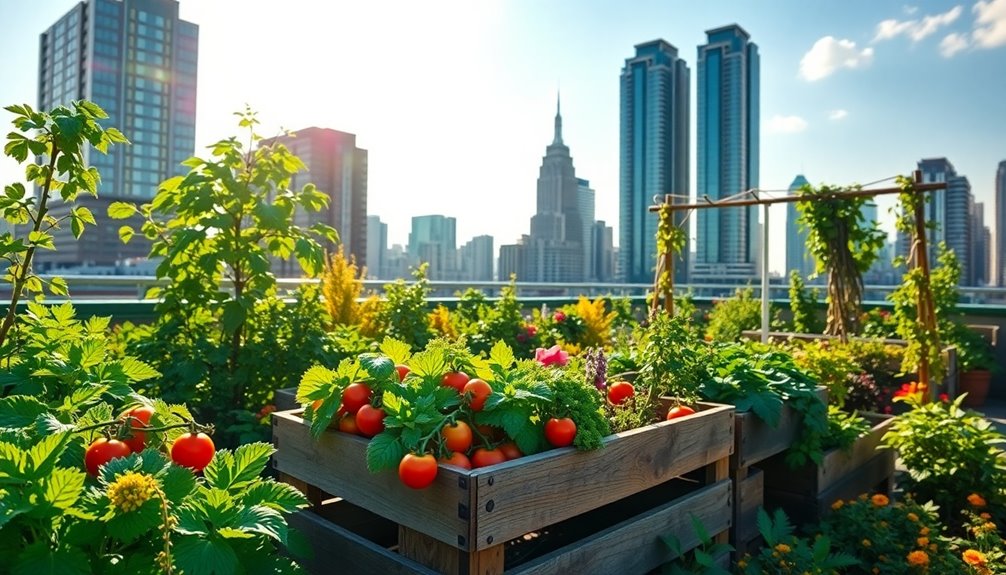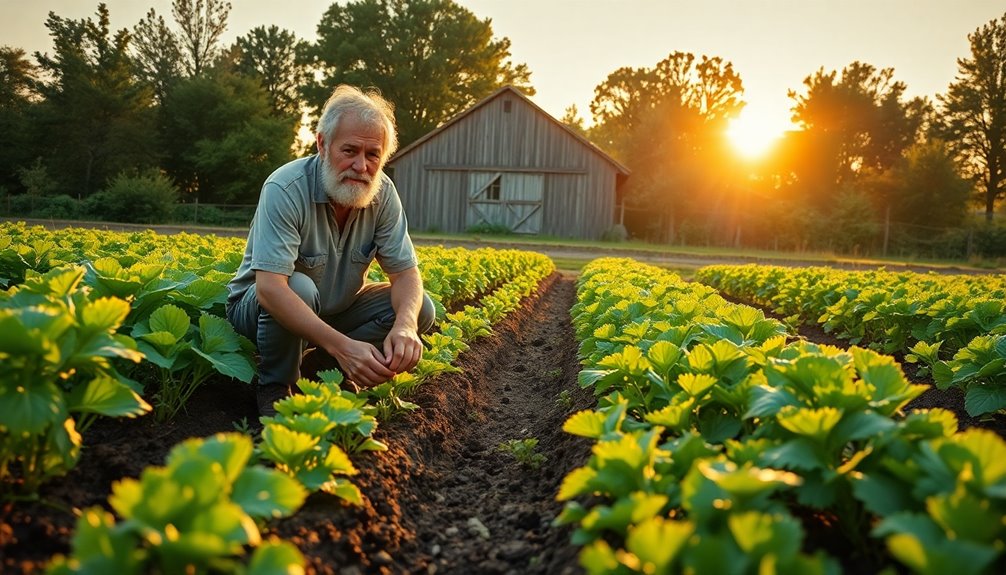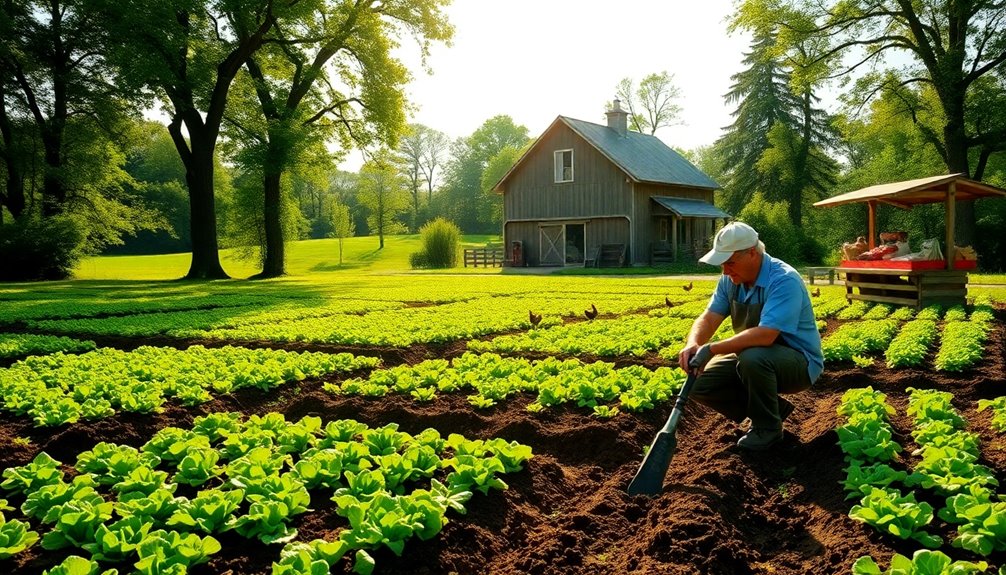Urban farming lets you transform your city space into a lush green oasis by growing crops and raising livestock right in your community. You can create vibrant gardens on rooftops, balconies, or vacant lots, providing fresh food and enhancing local biodiversity. This practice not only improves access to healthy produce but also reduces your carbon footprint and promotes social interactions among neighbors. By getting started, you'll discover techniques that suit small spaces and sustainable practices like composting. There's so much more to explore about how you can make your urban environment thrive with greenery and community spirit.
Key Takeaways
- Urban farming involves cultivating crops and livestock in urban areas, enhancing local food security and sustainability.
- Techniques such as community gardens, rooftop gardens, and vertical farms maximize space and resources.
- This practice improves access to fresh produce in food deserts, promoting healthier communities.
- Urban farming fosters community engagement and collaboration through shared gardening experiences.
- It also offers environmental benefits by reducing carbon footprints and promoting biodiversity in urban settings.
Definition of Urban Farming

Urban farming, at its core, is all about cultivating crops and raising livestock in city settings. This practice transforms unused spaces into green spaces, enhancing urban environments while promoting local food production.
You'll find various innovative techniques, such as community gardens, rooftop gardens, and vertical farms, designed to maximize city space for growing food. These initiatives not only contribute to food security by providing fresh produce but also embrace sustainable practices, reducing the carbon footprint linked to transporting food.
Urban farming has deep historical roots, with movements dating back to ancient times and gaining momentum during WWII. Today, it's intertwined with social justice efforts, ensuring equitable access to nutritious food while fostering community engagement through shared gardening initiatives.
Benefits of Urban Farming
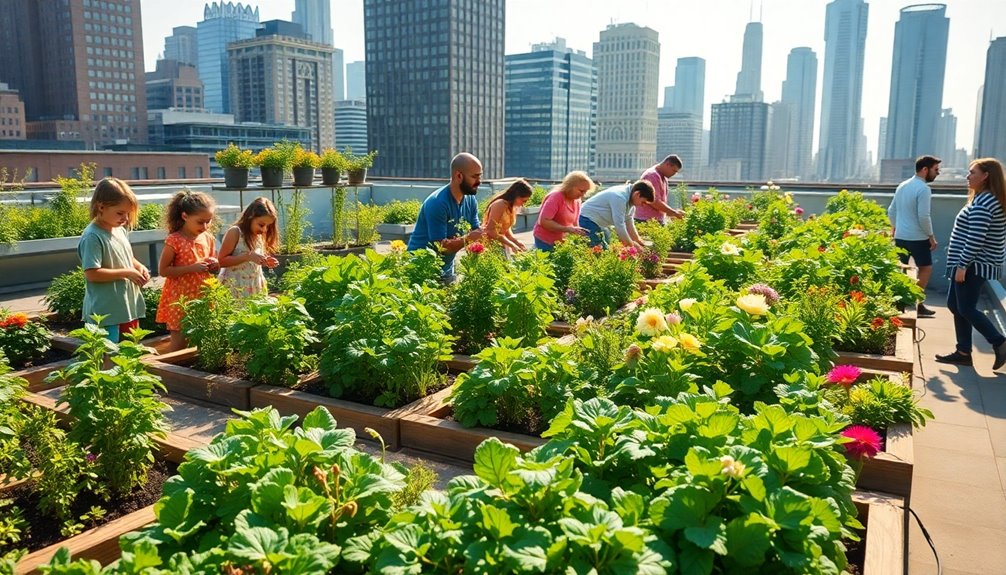
The benefits of urban farming extend far beyond just growing food; they play an essential role in enhancing food security and community well-being. Urban farming improves access to fresh food, particularly in food deserts, while fostering sustainable agriculture practices. It helps reduce the carbon footprint by sourcing produce locally, cutting transportation emissions. Community gardens not only promote biodiversity but also strengthen urban communities through social interaction. Additionally, urban farming yields significant economic benefits by creating jobs in agriculture and associated sectors, while increasing property values in green neighborhoods. Furthermore, engaging in urban farming can enhance cognitive growth through hands-on learning experiences that foster problem-solving skills.
| Benefit | Description | Impact |
|---|---|---|
| Food Security | Access to fresh food in food deserts | Improved health and nutrition |
| Environmental Impact | Reducing carbon footprint and promoting biodiversity | Healthier ecosystems |
| Economic Growth | Job creation and increased property values | Revitalized local markets |
Types of Urban Farming
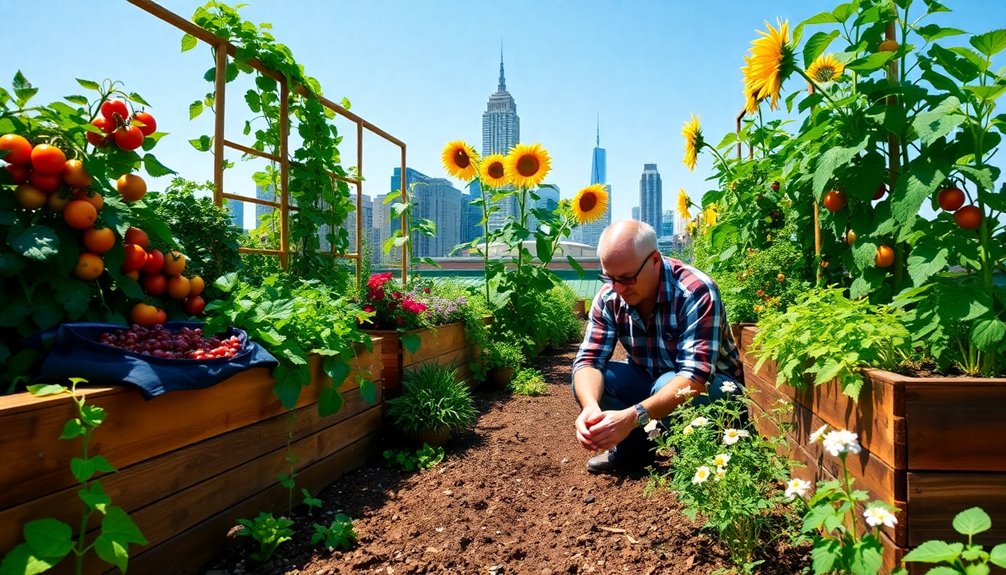
Various types of urban farming have emerged to meet the needs of city dwellers and enhance local food systems. Community gardens transform vacant lots into vibrant spaces where you can engage with neighbors while growing local food.
Rooftop gardens utilize building tops for farming, providing insulation and reducing energy costs. Vertical farms leverage stacked layers to maximize space and conserve water, producing more with less.
Urban farms often operate for profit, catering to local markets with niche produce. Additionally, institutional farms linked to schools and hospitals promote health initiatives and access to fresh produce.
Container gardens and green roofs further maximize urban gardening opportunities, creating sustainable urban environments that benefit everyone involved.
Getting Started With Urban Farming
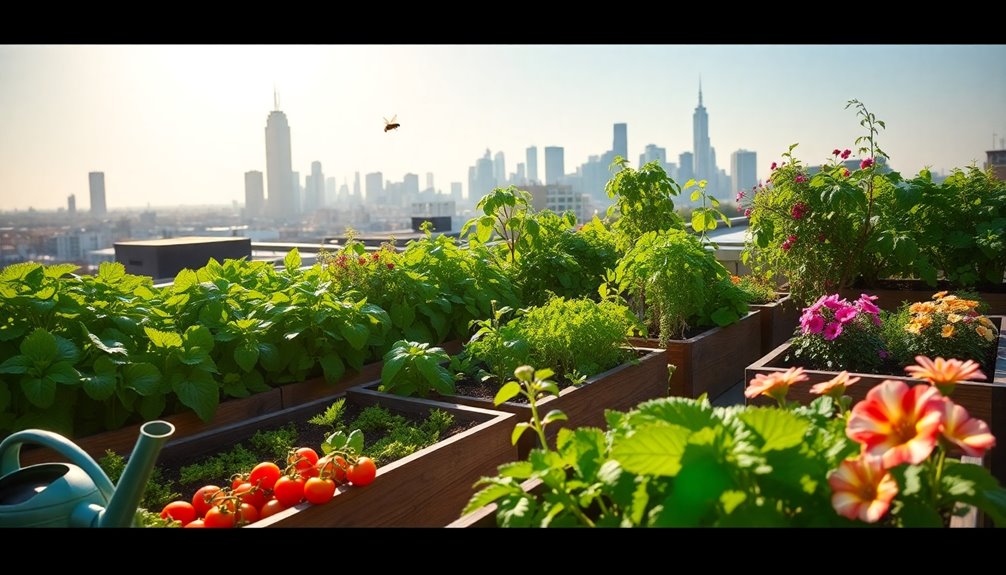
To commence your urban farming journey, start by evaluating the space you have available, whether it's a rooftop, balcony, or community lot. Identifying the right approach will maximize sunlight and accessibility.
Here are four steps to get started:
- Choose crops suited for small spaces: Begin with easy-to-grow herbs or leafy greens that thrive in containers or vertical gardens.
- Connect with local resources: Join community gardening programs or attend workshops to gain insights and meet fellow urban farmers.
- Implement sustainable practices: Compost kitchen scraps to boost soil health and minimize waste while cultivating fresh produce.
- Monitor your garden regularly: Verify adequate watering, nutrient-rich soil, and pest management for peak plant growth and yield.
Challenges of Urban Farming
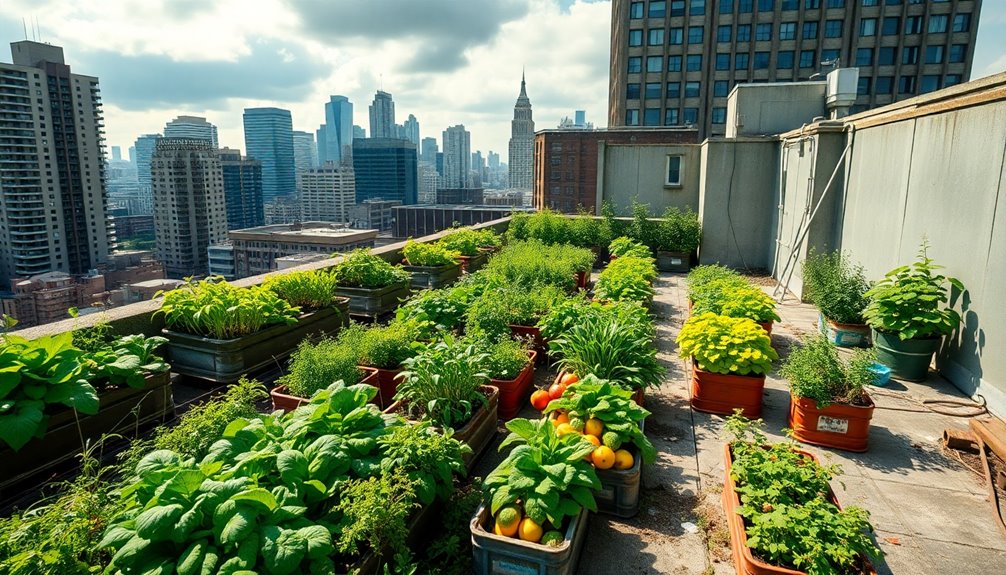
Urban farming presents unique challenges that can test the resolve of even the most dedicated growers. Limited space in urban areas restricts your ability to cultivate large-scale crops, pushing you to explore creative solutions like vertical farming and rooftop gardens.
Soil contamination is another concern, as you must conduct thorough testing and remediation to guarantee your produce is safe. Zoning laws may pose obstacles, with regulations often hindering agricultural activities in residential or commercial zones.
Additionally, access to water can be limited, making efficient management vital for sustaining your operations. Finally, economic viability is a pressing issue, as you'll face high operational costs and competition from larger farms.
Steering through these challenges is fundamental for successful urban farming.
Environmental Impact of Urban Farming
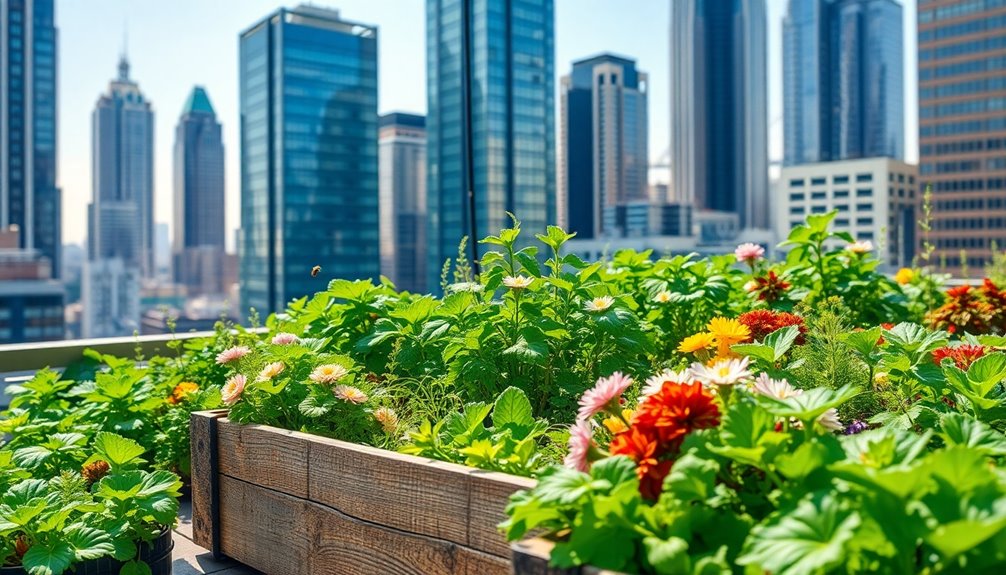
Frequently overlooked, the environmental impact of urban farming offers significant benefits that extend beyond just food production.
By transforming your city spaces into urban gardens, you contribute to a more sustainable environment. Here are four key impacts:
- Improving Air Quality: Green spaces can filter pollutants, reducing particulate matter in the air by up to 20%.
- Biodiversity: Urban farms support 30% more species than surrounding concrete areas, providing essential habitats for pollinators and wildlife.
- Reducing Carbon Footprint: Local food production cuts transportation emissions by up to 30%, enhancing sustainability.
- Mitigating Urban Heat: Vegetation can lower surrounding temperatures by up to 5°F, which helps combat the urban heat island effect.
Ultimately, urban farming enhances your city's green spaces, creating a healthier and more vibrant community.
Success Stories in Urban Farming
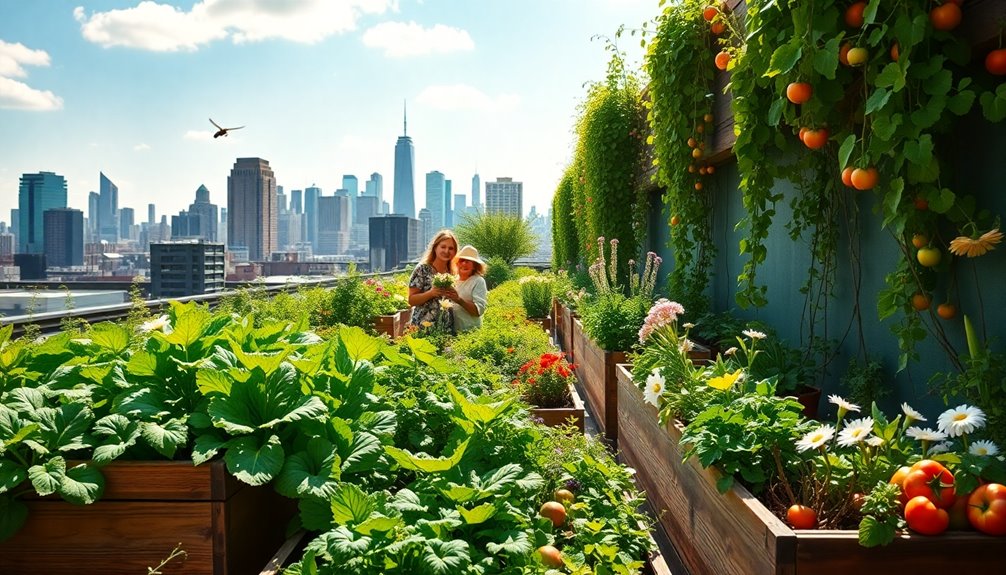
Success stories in urban farming illustrate how communities can thrive through innovative agricultural practices.
Projects like The High Line in New York City transform public spaces into green oases, attracting millions while promoting community engagement.
In Todmorden, the Incredible Edible initiative has increased local food production by 60%, enhancing food security and access to fresh, locally grown produce.
Montreal's Lufa Farms operates rooftop greenhouses, supplying over 12,000 families with fresh veggies and helping reduce the carbon footprint.
Brooklyn Grange, the largest rooftop farm in the U.S., produces 50,000 pounds of organic vegetables annually.
Additionally, Guerilla Gardening initiatives turn neglected areas into vibrant spaces, improving biodiversity and providing underserved communities with access to fresh food.
These success stories inspire urban gardeners everywhere.
Frequently Asked Questions
What Is the Meaning of Urban Farming?
Urban farming means cultivating food in city spaces, where you can grow crops and raise animals in areas like rooftops and community gardens.
It's about making use of limited space to provide fresh produce and enhance food access. You're addressing food deserts and contributing to sustainability by bringing agriculture closer to urban communities.
While you might face challenges like soil contamination, innovative methods can help you create a vibrant green space right where you live.
How Does Urban Farming Help the Environment?
Imagine your city as a bustling orchestra, and urban farming is the conductor, harmonizing nature and urban life. By cultivating green spaces, you're not just growing food; you're cooling your surroundings and improving air quality.
Your rooftop gardens absorb rainwater, preventing floods, while the plants provide homes for pollinators. Plus, growing food locally means fewer emissions from transport.
Each seed you plant helps create a healthier, more sustainable environment for everyone.
What Is Urban Farming Is Growing a Greener Future About?
Urban farming is about creating sustainable, green spaces in cities that can enhance your community's food system.
It allows you to grow your own food, reduce carbon footprints, and promote biodiversity.
By engaging in urban farming, you're not just cultivating crops; you're fostering connections with your neighbors and learning sustainable practices.
This movement encourages healthier eating habits and brings fresh produce closer to home, paving the way for a greener future.
What Are the Negative Effects of Urban Farming?
Urban farming can present several challenges.
You might face soil contamination due to heavy metals and pollutants, risking your crops' health.
Limited space often forces you into vertical farming or container gardening, complicating resource management.
Zoning regulations could restrict your agricultural activities, while high pest pressures might lead you to rely more on pesticides.
Additionally, access to water can be tough in urban settings, hindering your sustainable farming efforts.
Conclusion
So, who would've thought that turning your concrete jungle into a thriving green oasis could be so simple? Urban farming isn't just for those with vast fields or endless resources; it's for you, the city dweller, ready to dig in. As you embrace this journey, you'll find that even the smallest patch of soil can yield big rewards. Just remember, while you're growing veggies, you're also cultivating a sense of community—and maybe a little irony in a place known for its hustle.

